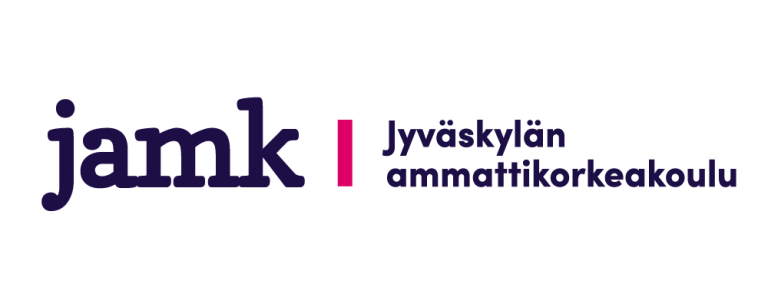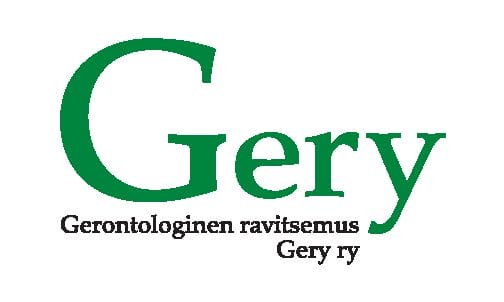
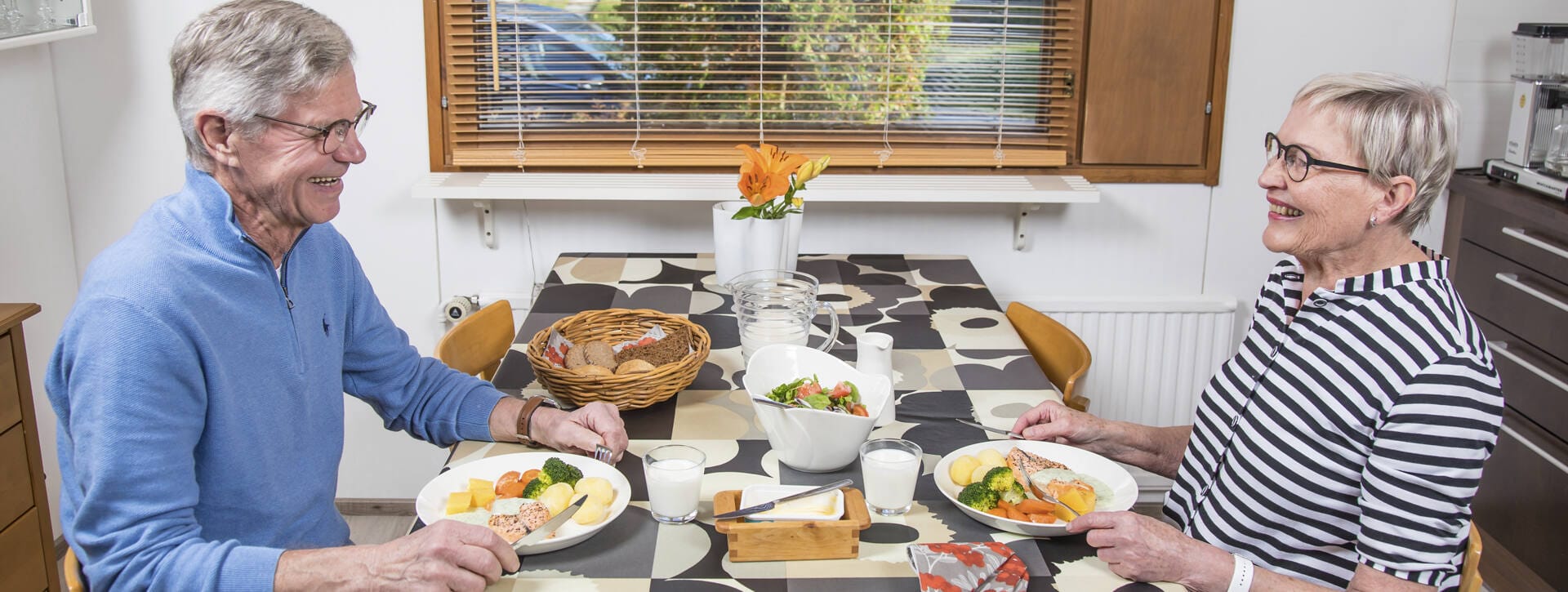
Ikäruoka 2.0
Multiform food related services to promote older people's sense of community and functional capacity
Multiform food related services to promote older people’s sense of community and functional capacity – the Ikäruoka 2.0 project
The project is finished.
Finland’s population is ageing rapidly and innovative actions are needed to improve the wellbeing and functional capacity of older people living at home. Promoting healthy and social eating is one important development target, as it helps improve older people’s health and quality of life. In addition, services supporting healthy and social eating make it possible for older people to live at home for as long as possible, which they also often prefer. Promoting living at home also slows down the increase of future social and health care costs.
Goals
The project aims were:
- to support older adults’ healthy eating, ability to function and sense of community.
- to develop multiform food related services for older adults living at home.
- to promote multisectoral regional collaboration to develop local food related services.
This project’s key concept multiform food related services refers to a wide range of services which enable health-promoting food choices for older adults living at home.
The multiform food related services include:
- food services
- grocery stores
- food delivery services
- online food ordering applications
- transportation – access to food services
- assisting, advisory and counselling services.
In optimal cases, all these services are designed by user-centred approach also from older adults’ perspective so that their own residential area would provide services that are of high quality, attractive, acceptable and affordable.
Target group
This project aimed to develop food related services especially for older adults living at home. They are people over the age of 65 in good condition or people with some illnesses and fragility, but without regular need for help in their everyday life.
In addition, special attention was paid to the service needs of older adults in particular risk of having eating habits that do not promote wellbeing and ability to function, such as
- newly retired
- newly widowed
- people living alone
- people with impaired cognition or functional capacity.
The Ikäruoka 2.0 project aimed to promote older adults’ healthy and social eating in different residential districts – urban areas, countryside – by developing services and service models in regional multisectoral collaboration.
Photo: Xamk
News
New Finnish food recommendation for older adults
Finland received a new food recommendation for older adults in 2020. The recommendation is an important background document for our project. The first part of the recommendation defines how to support the healthy eating habits of older adults living at home.
The recommendation has also been published in English, and the ebook is available on the website: Vitality in later years: food recommendation for older adults. 2020. National Nutrition Council and Finnish Institute for Health and Welfare (THL).
Understanding older adults through functional capacity
Finnish legislation defines older adults as people over the age of 65 years. When discussing nutrition, it is more appropriate to understand older adults according to their state of health and functional capacity rather than their age.
Finnish food recommendation groups older adults according to functional capacity under four categories (Figure 1). The Ikäruoka 2.0 project aimed to develop food related services for the older adults belonging to the two lowermost groups of Figure 1. They are people in good condition or people with some illnesses and fragility, but without regular need for help in their everyday life.
However, the needs of older adults vary in terms of services that support living at home. The goal of Ikäruoka 2.0 was to maintain functional capacity and enable living at home as long as possible by developing services for older adults. Eating together at a local restaurant increases the pleasure of eating, encourages people to test new foods, helps those with poor appetite to eat more, and promotes older adults’ sense of community. Help with shopping or food product delivery services increase the possibilities to live at home. Cooking and baking by themselves can be activating and bring meaningfulness to everyday life and provide a rhythm for the day.
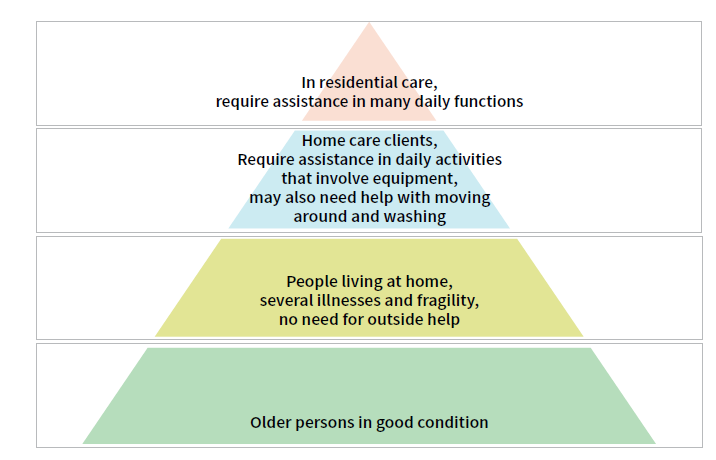
Pilot areas
In Finland, most people live in the southern part of the country. There is a wide variety of services, and the distances from home to local restaurants and grocery stores are short. However, the distances in the central and northern regions of Finland are long, and a lot of people live far from services.
Our project assumed that older adults living in urban areas have different needs for services than those living in the countryside. That was why we had three pilot areas which were different kinds of residential areas. Järvenpää was an urban area in Southern Finland, and in Jyväskylä, we had the city centre as the pilot area. The pilot areas of South Savo involve Juva and Mäntyharju which represented the countryside. Table 1 gives further information on the pilot areas.
Table 1. Area and population of pilot areas
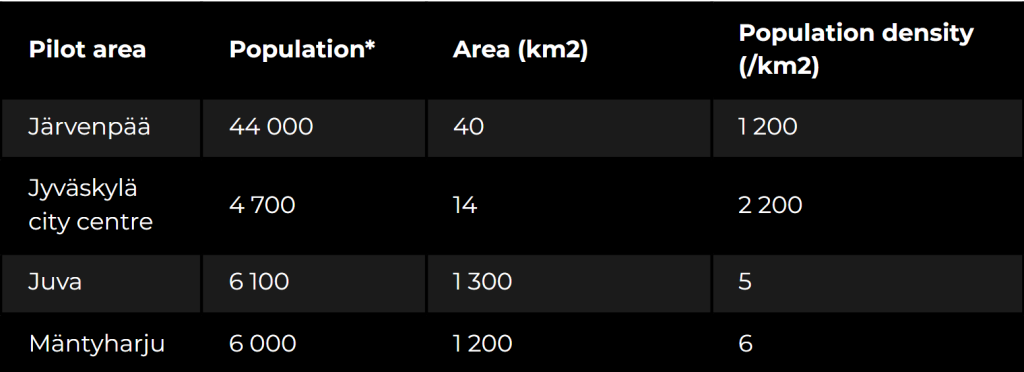
* 2019

Local food environment of older adults
Our project assumed that older adults living in urban areas have different needs for services than those living in the countryside. The project further assumed that an understanding of the local food environment helps us to develop better regional services for older adults. For this reason, the local food environment was studied in each pilot area.
First, basic information about the regional food related services was collected in each pilot area: How many restaurants and grocery stores are in the area and where are the services situated? Next, the project made observations of these services from older adults’ point of view. The focus was on availability and accessibility. Furthermore, older adults living in the area were interviewed on the phone.
These three project steps showed that the food related services of the rural municipalities were located in the municipal centres, a long way from smaller villages, and the local transportation to access the services was poor. In addition, the observations of pilot areas showed that there already were good food service related practices (Pictures 1-3), but also challenges and development targets.
Picture 1: Special shopping trolley for older adults
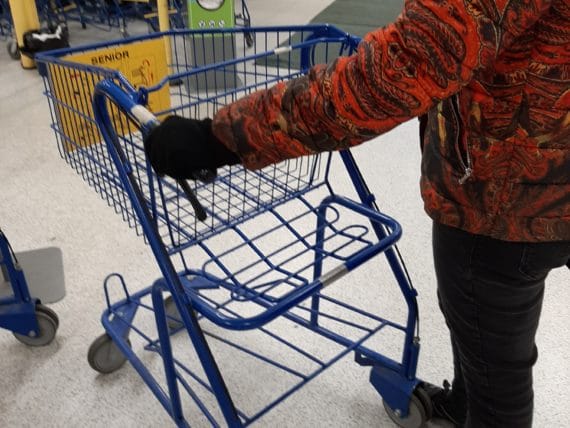
Picture 2: Taxi stand close to a grocery store entrance
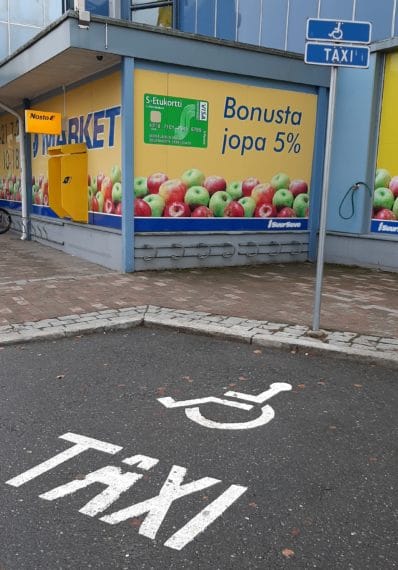
Picture 3: Versatile buffet lunch at a local restaurant
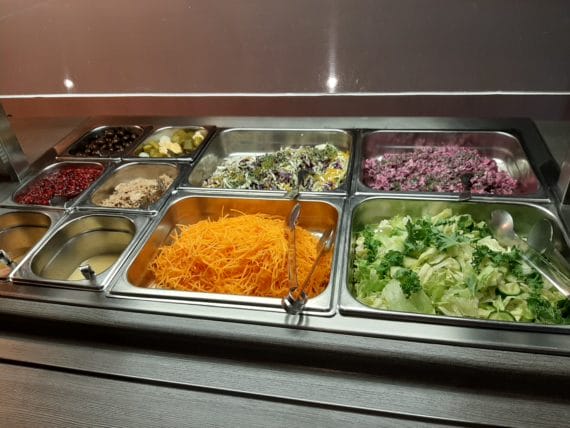
Multisectoral groups develop regional services
During the years 2021–2022, the Ikäruoka 2.0 project promoted multisectoral collaboration to develop food related services for older adults. The aim was to innovate and test new services that would improve older adults’ sense of community and functional capacity and be available in their own residential area. A user-centered approach was adopted to ensure that these new services would be of high quality, attractive, acceptable and affordable particularly from older adults’ perspective.
The project was carried out in four pilot areas in close cooperation with local operators. The pilot areas included different kinds of residential areas: Järvenpää, an urban area in Southern Finland, Jyväskylä city centre and Juva and Mäntyharju municipalities, representing rural residential areas. How this development work took place in the South Savo regions of Juva and Mäntyharju is described below.
Iterative development in improving regional food related services
The process which our project team tested in this regional development collaboration based on the iterative design methodology. This methodology aims at a continuous cyclic development process of prototyping, testing, analysing, and refining the service based on what has been learnt from the tests. Our process also applied the basic principles of service design, that is, the systematic innovation process with four steps: discover, define, develop and deliver. Both iterative development and service design offered a practical, customer-oriented approach to the collaborative service development with customers, service providers and other stakeholders.
Figure 2 shows the detailed steps of the iterative process we modified for the purposes of the Ikäruoka 2.0 project’s regional development collaboration in the South Savo pilot areas.
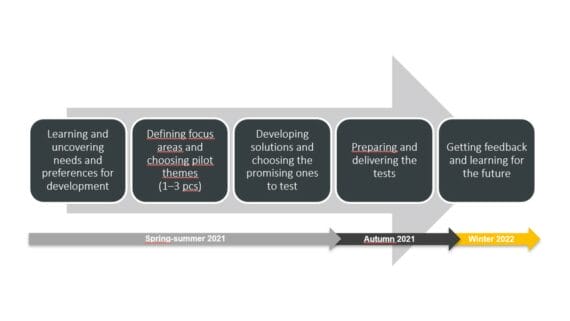
Active collaboration in multisectoral regional development groups
The regional activities started by contacting the local stakeholders from the public, private and the third sector (see Figure 3). We invited them to participate in informal, collaborative development groups and interviewed them briefly to find out their preliminary interests and needs for development in local food related services. We also inquired which other stakeholders should be recruited to the development group or at least be informed of the project to ensure that as many essential local parties as possible would know and/or participate in the development.
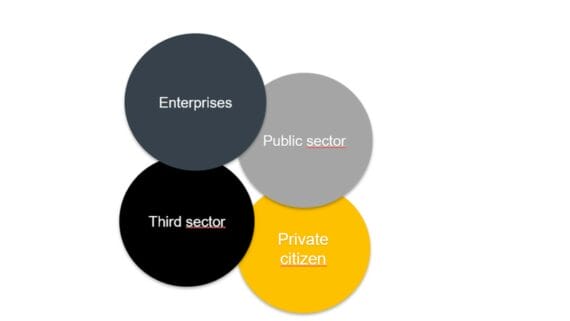
Everyone interested in improving the local food related services for older adults were welcomed to join this regional collaboration throughout the process. All in all, over 70 representatives of different stakeholders – about 35 per pilot area – contributed to the co-creation of new services and test preparations.
The list below summarises the parties of the regional development groups in the South Savo pilot areas Juva and Mäntyharju.
- Eight food service companies and one grocery store
- Food service providers of the municipalities
- The South Savo social and health care authority (Essote)
- Members of the senior citizens’ councils
- Representatives of the municipalities’ staff (public transportation, local business promotion)
- Several associations in Juva and Mäntyharju: staff members and volunteers, including for example
- local associations of three different pensioners’ organisations
- local associations of Rural Women’s Advisory Organization
- local associations of The Martha Organization
- local associations of some patients’ organisations
- associations of several villages of the pilot municipalities
- Parishes of the municipalities
- Representatives of older adults
We launched the regional development groups in the virtual kick-off events arranged separately for each pilot area. The following collaborative activities included 7–8 remote or live workshops per pilot area and several meetings with the single parties or sub-groups of the regional development groups.
Typically, the service providers, older adults and other stakeholders contributed together to most steps during our development process (see Figure 2). However, the service providers were independently in charge of the practical arrangements and the production of the test services, such as providing catering for events that we named Dining together events.
Need for development
During the development process, we learnt that older adults of the pilot areas had many development needs concerning food related services. Services with need for development are listed below:
- Dining together in public establishments or at home
- Assisting and advisory services for shopping
- Marketing and availability and accessibility of the information about food related services
- Transportation and delivery services
- Entertainment, activities and/or advisory services along with dining together
- Local food events for older people
- Reusing school kitchen food waste for preparing low-price meals
- Promoting the use of service vouchers for cheaper food services
The next step in the process was to prioritise the above themes. The locals found the first four themes as the most essential ones, and based on their choices we began to plan the tests and looked for new partners, for example, taxi entrepreneurs, to join our development activities.
We had a criterion that we would only arrange tests for which local service providers were committed to. It was also important that potential customers, such as representatives of pensioners’ associations, were truly interested in testing the new services.
Based on these criteria and prototypes, we planned and delivered 10 tests of Dining together events with different food service providers. Also partners from our development groups, such as a few associations from Juva and Mäntyharju and local associations of pensioners’ organisations joined the tests.
Customer feedback was collected after events. Participants gave mainly very positive feedback. The older adults participated in the events made a point of being together and socialize with other participants, not only good food. Planning and testing events together increased the interaction between the service providers, older adults and other stakeholders and encouraged them to cooperate with others.
Customer feedback was collected after the events, and it was mainly very positive feedback. The older adults participated in the events appreciated getting together and socialising with other participants, not only good food. Planning and testing events together increased the interaction between the service providers, older adults and other stakeholders and encouraged them to cooperate.
Dining together events met several expectations and needs
The older adults and service providers in all pilot areas considered Dining together events to be the most important and interesting development idea. Different service concepts for these events were tested in each area. The events were organized in restaurants, in community premises and in care homes. Moreover, the events differed in terms of food price, social programme and time of the day.
Dining together events met several expectations and needs of the local parties. The expectations and needs of the older adults interested in these events are listed below:
- delicious, versatile, reasonably priced food
- possibility to meet other people in calm surroundings
- refreshment for mind
- reason to leave home
- relief from cooking
The expectations and needs of the local service providers interested in Dining together events are the following:
- developing the range of the services
- receiving new customers and increasing the number of the visits in the restaurant
- increasing the number of lunch customers especially outside peak hours
- getting information about the older adults’ service needs
- improving the age-friendliness of the services
- getting information about the effective marketing channels for older adults
- acting socially responsibly and promoting the wellbeing of older adults living in the area
- extending cooperation networks
Dining together events reminded older adults of it how important adequate and versatile eating and food choices are for their wellbeing. Moreover, the events encouraged them to use the local food services and to improve eating at home, too. For service providers, these events gave an opportunity to share and get information about the challenges and services important for older adults living in the area.
Developing food related services for older adults is our collective responsibility
The goal of the Ikäruoka 2.0 project was to support older adults’ healthy eating, ability to function and the sense of community. At the same time the project aimed at developing multiform food related services for older adults living at home and promoting multisectoral regional collaboration to upgrade local food related services.
Practical guidelines and idea lists for future developers
The Ikäruoka 2.0. project planned, delivered and evaluated 10 tests during the so-called Dining together events. These events encouraged older adults to use local food services and to improve eating at home, too Based on the test practical guidelines for the future organisers of this type of events were developed.
The local collaborative development groups had many development needs concerning food related services. They brainstormed together several food related service ideas for older adults to solve such problems. During the development process, the ideas were prioritised and the most essential ones were developed further. Because we had a criterion that we would only arrange those tests for which local service providers were committed to, most of the ideas were excluded from the tests. Only Dining together events were tested. Nevertheless, brainstorming was not unnecessary because all ideas were listed for future developers. Moreover, practical tools for starting and managing the development process of the regional group were described in guidelines for arranging Dining together events.
The operating model describes local actors and their roles
During the development process, new practices for regional development collaboration was tested. As a result, an operating model was developed for future developers. The project proved that regional cooperation produces good results. The main message of the project is that food related services for older adults should be developed through cooperation.
Many people in cities and municipalities − such as local residents, public and private operators and the third sector − can promote older adults’ healthy and social eating and living at home. Additionally, these parties can improve older adults’ wellbeing and functional capacity. The operating model created lists local actors who can take part in development work and describes their roles. The model promotes the active collaboration in multisectoral regional groups using a user-centered approach and an iterative development process.
Close cooperation with local parties and dialogue between the older adults and the local service providers increased mutual trust and understanding. The multiform food related services planned and tested together ensured that all parties benefited from the services. The user-centered approach of the development was adopted to ensure that these new services would be of high quality, attractive, acceptable and affordable particularly from older adults’ perspective.
Interaction and communication between all parties are important
In the multisectoral collaboration, interaction and communication between all parties play an important role. In that way, the development needs and ideas of all parties can be taken into account and all parties find the collaboration useful and valuable. Moreover, interaction and communication between all parties help to achieve a common and motivational development target and to encourage people to be involved in the development process.
The operating model divides the communication of the multisectoral collaborations into two parts: the internal communication of local development groups and into the communication between these groups and the decision-makers and policy-makers of municipalities. Furthermore, the communication of the decision-makers and policy-makers of municipalities can be divided into lobbying, and into communication supporting the local development work and exchange of information between all parties.
Lobbying means that decision-makers and policy-makers take older adults’ nutrition health into account when they plan the health promotion relating to older adults in their area. Interaction and communication between all parties ensure that the materials, expertise, networks and resources of nutrition health will be available for local developers. Above all, effective development of regional services requires a coordinator for the multisectoral collaboration. This coordinator should take responsibility for all communication and information during the development process. Support for older adults’ healthy eating, ability to function and sense of community can be achieved when working together.
Ikäruoka 2.0
Info
Budget
